Compared to 1900s lingerie, 1920s lingerie looks completely different but women still wore the same kind of underwear: chemises, drawers, camisoles, bras, girdles and corsets. Yes, most women in the 1920s still wore corsets! However, Edwardian lingerie emphasized a curvy silhouette, whereas 1920s underwear created a slender, boyish look.
‘Daintiness, absolute freshness, and simplicity should be the keynote of all lingerie. At the same time, it should be remembered that undergarments must be carefully fitted and correctly designed in order that outer garments may be properly effective.’ (Underwear And Lingerie, 1925)
1920s Lingerie Fabrics
1920s lingerie fabrics were delicate and flowy: Silk chiffon, crepe de chine and sheer cotton were popular lingerie fabrics. So, even if 1920s dresses were cut straight and loose fitting, curves were not concealed because of the thin fabrics.
‘In the features to be sought in lingerie material, perhaps the one of most importance is durability, or the quality to withstand the hard wear of frequent laundering […] Silk has many favorable features, the chief of which is perhaps its wearing quality […] To many women, the luxuriousness of silk is a desirable point […]
At the same time, however, silk has an economical feature to recommend it, for while its initial cost is greater […] the increased wear it gives will make its purchase for underwear a good investment. Crepe de Chine probably enjoys the most favor as a silk lingerie fabric […] Silk Jersey […] makes a very practical material for vests. […] Cotton […] is the fabric in most general use’. (Underwear And Lingerie, 1925)
1920s Lingerie Colors
Popular colors for 1920s lingerie were white, black and pastel colors such as peach, pink, mint green and turquoise. ‘Pink, light blue, mauve and yellow. It will make the prettiest kind of chemises and nightdresses or bloomers, drawers and camisoles.’ (A Complete Course In Dressmaking, 1921, p. 2)
‘In years past, practically all lingerie was made up in white material, whether silk, cotton, or linen was used, but of recent years colored lingerie has come into vogue. […] tea-rose pink, hydrangea blue, orchid, leaf green, and buttercup yellow are as frequently seen as white. Of the pastel tints, flesh pink is the most commonly used, with orchid the next choice.
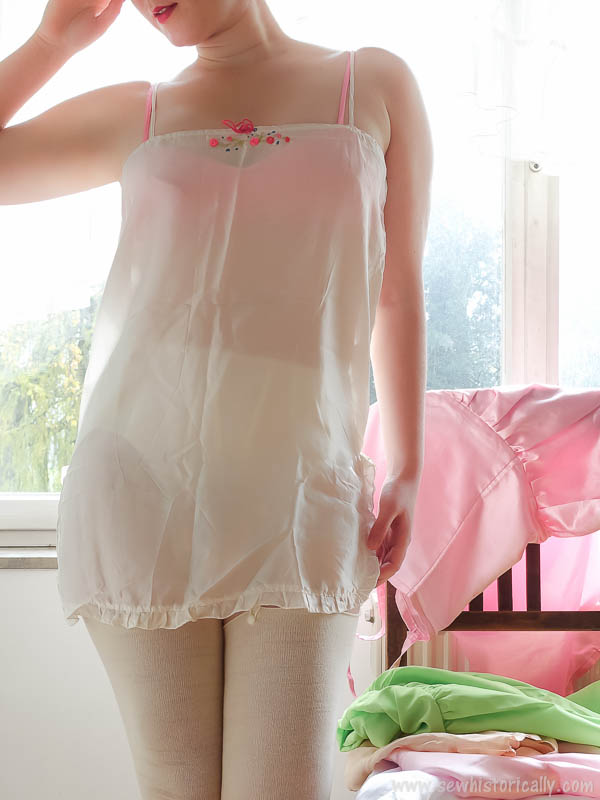
Related: 1920s Silk Step-In Chemise
Peach also has a large following among lingerie enthusiasts, and tan is in such a demand that shops display a sizable stock in this color. Although black is far from a pastel tint, it is sanctioned as appropriate under black dresses, especially for mourning and for evening wear.
In spite of the enthusiasm over colored underwear, it must be kept in mind that good taste does not allow of a general use of colorful lingerie under transparent outer clothing. Exception is made in the case of a slip, which often provides the means of emphasizing a particularly pleasing color contrast and thus becomes a part of the outfit, or when the underwear matches the dress, even though the latter is sheer and of a bright color.’ (Underwear And Lingerie, 1925)
For The Sewing Beginner
Sewing underwear and nightwear is perfect to practice your sewing skills: ‘Underwear offers one of the best opportunities to become an efficient sewer. Then, too, you will probably enjoy having a few new pieces of underwear. Every woman always has room for just one more dainty chemise or nightdress.’ (A Complete Course In Dressmaking, 1921, p. 1)
No Pattern Needed
‘Because of the simplicity of present-day undergarments, in many cases no pattern is necessary as a guide in cutting. Instead, simple, concise directions may be followed with excellent results, the only tools necessary being a yardstick, a tape measure, scissors, pins, tailors’ chalk, and a pencil.’ (Underwear And Lingerie, 1925)
What 1920s Lingerie Should I Wear?
You don’t have to wear all of the following 1920s undergarments! 😉 If you want to wear the least possible 1920s underwear, you could wear one of the following combinations:
-
Bra + Tap Pants + Slip
-
Envelope Chemise + Slip
Dressing The 1920s Woman – 1920s Lingerie
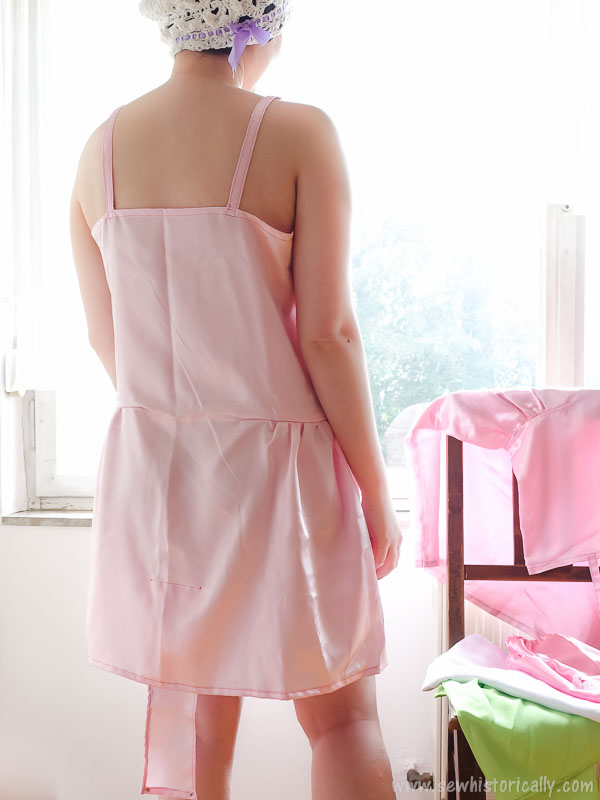
The Envelope Or Step-In Chemise
Next to the skin, 1920s women wore a teddy, also know as step-in chemise, or an envelope chemise. While 1920s envelope and step-in chemises look like a short slip, they had flap between the legs turning the slip into a knickers-slip-combination. Basically, they are like a romper or onesie. It was a favorite among 1920s flappers who preferred to wear only the bare necessities under their dresses!
Related: 1920s Pink Satin Envelope Chemise
However, there’s a slight difference between 1920s envelope chemises and step-ins: While envelope chemises closed at the crotch with snaps or buttons, step-in chemise only had the flap without a closure: You literally had to step into the chemise, therefore the name!
The ‘place [of the chemise] has been taken by the knitted undervest of either silk or cotton. The chemise in its new guise is called the envelope, or the step-in chemise, and the combination underwaist and drawers. The difference between the two is that the envelope, or step-in chemise is evidently one garment, while the combination is really two garments joined together.’ (Underwear And Lingerie, 1925)
Vest Or Camisole
Some women, especially working class women, wore a vest – or camisole – and tap pants instead of a teddy.
‘One of the undergarments that is easiest to make is a ribbon camisole that slips on over the head.’ (A Complete Course In Dressmaking, 1921, p. 54)
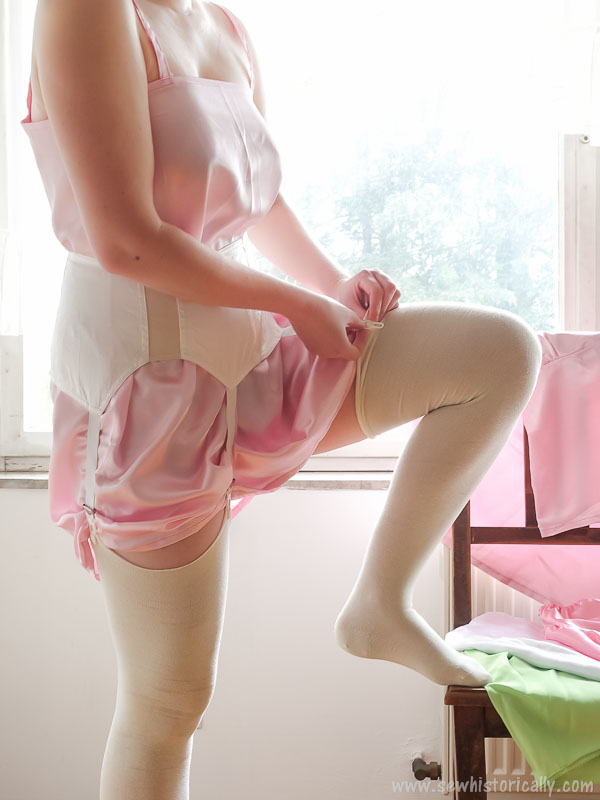
The Girdle
In the 1920s, women either wore rolled stockings or a girdle to hold up the stockings. The girdle ‘gives a perfect contour by holding down the hip and holding in the abdomen.’ (H&W Girdle Ad, 1924) ‘Resilient elastic inserts assuring ease and grace – and Featherbone to give the necessary firmness – are a few of its special features which appeal to the woman who, though seeking comfort, insist on style.’ (Warren’s Featherbone Girdle Ad, 1924)
Here’s an antique 1920s girdle at the MET and a photograph of three women wearing girdles over step-in chemises.
The Brassiere
In the 1920s, a flat-chested, straight silhouette was in. The ‘purpose [of the brassiere] is to confine the bust and to give an appearance of firmness and trimness to the figure under the arms and across the back as well. The true brassiere opens in the back or under the arm, although, for those who find it more convenient, a center-front opening is provided.
The general use of the brassiere has been brought about by the adoption of the low-bust corset, which requires the wearing of a confining band so that the upper part of the figure will appear trim especially when a one-piece dress is worn. At the same time, however, care must be taken that the brassiere is quite large enough, for there is nothing that makes a woman more uncomfortable than the wearing of too small a garment of this kind.’ (Underwear And Lingerie, 1925)
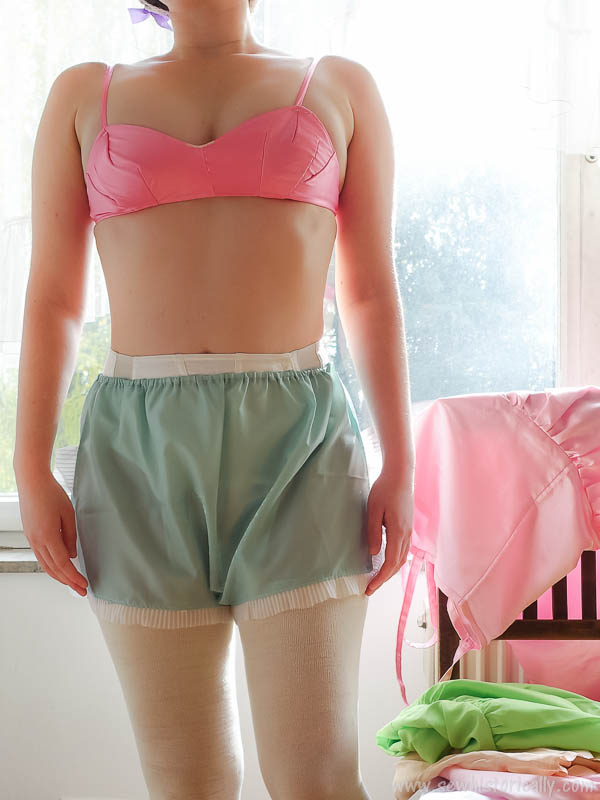
Bra, Tap Pants & Girdle
Instead of a step-in or envelope chemise, some women in the 1920s prefered to wear a bra and tap pants. The girdle was usually worn under the tap pants. 1920s photograph of a woman wearing a bra and girdle.
Related: 1920s Tap Pants
Here‘s a 1920s photograph of two women, one wears a bra and tap pants, while the other wears a teddy.
‘While the one-piece undergarment, such as the envelope chemise or the combination, enjoys deserved favor, there are many women who prefer a separate vest and drawers or bloomers, especially those women who find a brassiere a necessity. When properly made and fitted, drawers or bloomers will be found to be quite as satisfactory a foundation as either of the other garments’. (Underwear And Lingerie, 1925)
The Corset
Contrary to popular belief, women in the 1920s still wore corsets and corselets. However, corset were no longer worn to create a curvy silhouette but to make the figure appear slimmer. ‘It gives the unbroken straight line and may be worn under evening frocks […] as well as for sports wear.’ (Delineator, 1925)
1920s corset were still boned but they usually had elastic gores at the hips. While older women wore corsets, younger women preferred corselets: ‘Women with young, slender figures find that the corselet, which is a combination brassière and hip-confiner, is sufficient.’ (Delineator, 1925)
Here’s a 1920s photograph of a woman wearing a corset, an antique 1925 corselet at the MET, a 1920s Bien Jolie corset with lace and a 1920s corselet pattern.

The Slip
The slip was the last layer under the dress. Because 1920s dresses were often very sheer, wearing a slip was an absolute necessity! Slips ‘are frequently used for wear under sheer summer dresses.’ (Clothing For Women: Selection, Design, Construction, 1917)
Related: My 1920s Slips
‘A slip serves, first of all, the main function of making the correct foundation for a dress; in other words, of setting off a dress by giving it good lines or by helping it to maintain the good lines of its own design. Then, too, there is the protective function that is so essential for a slip to serve, for the fact that a slip is a very necessary part of clothing must never be overlooked.’ (Underwear And Lingerie, 1926)
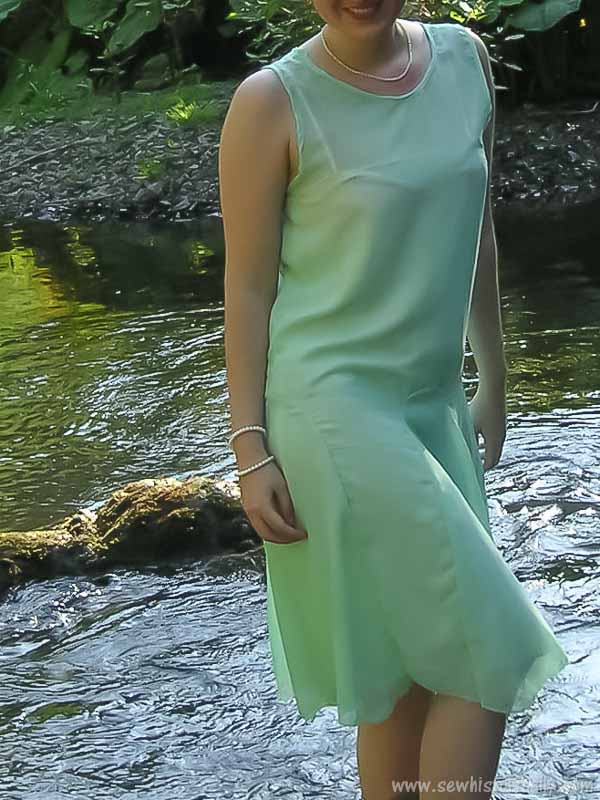
Related: 1920s Mint Green Chiffon Dress
More About The History Of Lingerie
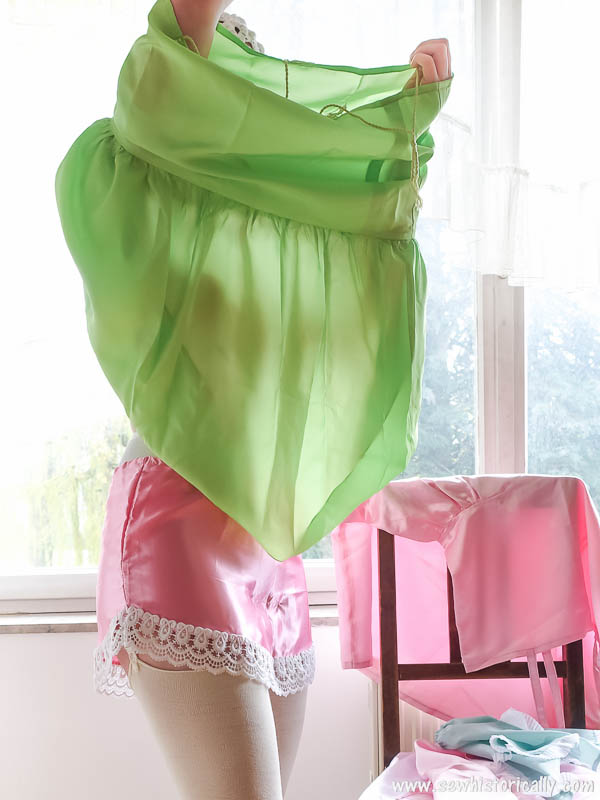
Wonderful plethora of extremely useful information; thank you so much for sharing! I am making some 1920s outfits for my next book signings (the story in my novel happens in 1924) and this post will help me with the lingerie. A thousand thanks!
Thank you! Glad you like it! 🙂
Absolutely brilliant! I’m a novelist and finding this wealth of information has been invaluable. Thank you.
Thank you! Glad you find it helpful!
This was so interesting and informative. I love your detailed photographs and links to more info. Your site is extremely well put together. Thank you so much for this treasure trove. I’ll be back!
Thank you so much! 😀 Glad you like it!